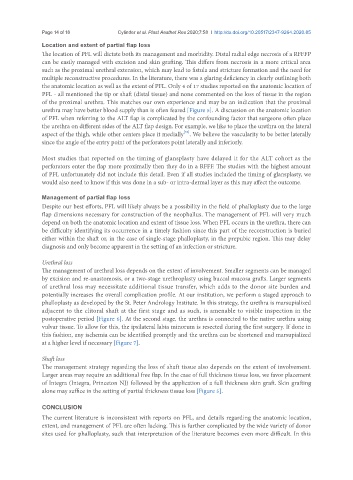Page 680 - Read Online
P. 680
Page 14 of 18 Cylinder et al. Plast Aesthet Res 2020;7:58 I http://dx.doi.org/10.20517/2347-9264.2020.85
Location and extent of partial flap loss
The location of PFL will dictate both its management and morbidity. Distal radial edge necrosis of a RFFFP
can be easily managed with excision and skin grafting. This differs from necrosis in a more critical area
such as the proximal urethral extension, which may lead to fistula and stricture formation and the need for
multiple reconstructive procedures. In the literature, there was a glaring deficiency in clearly outlining both
the anatomic location as well as the extent of PFL. Only 4 of 17 studies reported on the anatomic location of
PFL - all mentioned the tip or shaft (distal tissue) and none commented on the loss of tissue in the region
of the proximal urethra. This matches our own experience and may be an indication that the proximal
urethra may have better blood supply than is often feared [Figure 5]. A discussion on the anatomic location
of PFL when referring to the ALT flap is complicated by the confounding factor that surgeons often place
the urethra on different sides of the ALT flap design. For example, we like to place the urethra on the lateral
[32]
aspect of the thigh, while other centers place it medially . We believe the vascularity to be better laterally
since the angle of the entry point of the perforators point laterally and inferiorly.
Most studies that reported on the timing of glansplasty have delayed it for the ALT cohort as the
perforators enter the flap more proximally then they do in a RFFF. The studies with the highest amount
of PFL unfortunately did not include this detail. Even if all studies included the timing of glansplasty, we
would also need to know if this was done in a sub- or intra-dermal layer as this may affect the outcome.
Management of partial flap loss
Despite our best efforts, PFL will likely always be a possibility in the field of phalloplasty due to the large
flap dimensions necessary for construction of the neophallus. The management of PFL will very much
depend on both the anatomic location and extent of tissue loss. When PFL occurs in the urethra, there can
be difficulty identifying its occurrence in a timely fashion since this part of the reconstruction is buried
either within the shaft or, in the case of single-stage phalloplasty, in the prepubic region. This may delay
diagnosis and only become apparent in the setting of an infection or stricture.
Urethral loss
The management of urethral loss depends on the extent of involvement. Smaller segments can be managed
by excision and re-anastomosis, or a two-stage urethroplasty using buccal mucosa grafts. Larger segments
of urethral loss may necessitate additional tissue transfer, which adds to the donor site burden and
potentially increases the overall complication profile. At our institution, we perform a staged approach to
phalloplasty as developed by the St. Peter Andrology Institute. In this strategy, the urethra is marsupialized
adjacent to the clitoral shaft at the first stage and as such, is amenable to visible inspection in the
postoperative period [Figure 6]. At the second stage, the urethra is connected to the native urethra using
vulvar tissue. To allow for this, the ipsilateral labia minorum is resected during the first surgery. If done in
this fashion, any ischemia can be identified promptly and the urethra can be shortened and marsupialized
at a higher level if necessary [Figure 7].
Shaft loss
The management strategy regarding the loss of shaft tissue also depends on the extent of involvement.
Larger areas may require an additional free flap. In the case of full thickness tissue loss, we favor placement
of Integra (Integra, Princeton NJ) followed by the application of a full thickness skin graft. Skin grafting
alone may suffice in the setting of partial thickness tissue loss [Figure 5].
CONCLUSION
The current literature is inconsistent with reports on PFL, and details regarding the anatomic location,
extent, and management of PFL are often lacking. This is further complicated by the wide variety of donor
sites used for phalloplasty, such that interpretation of the literature becomes even more difficult. In this

